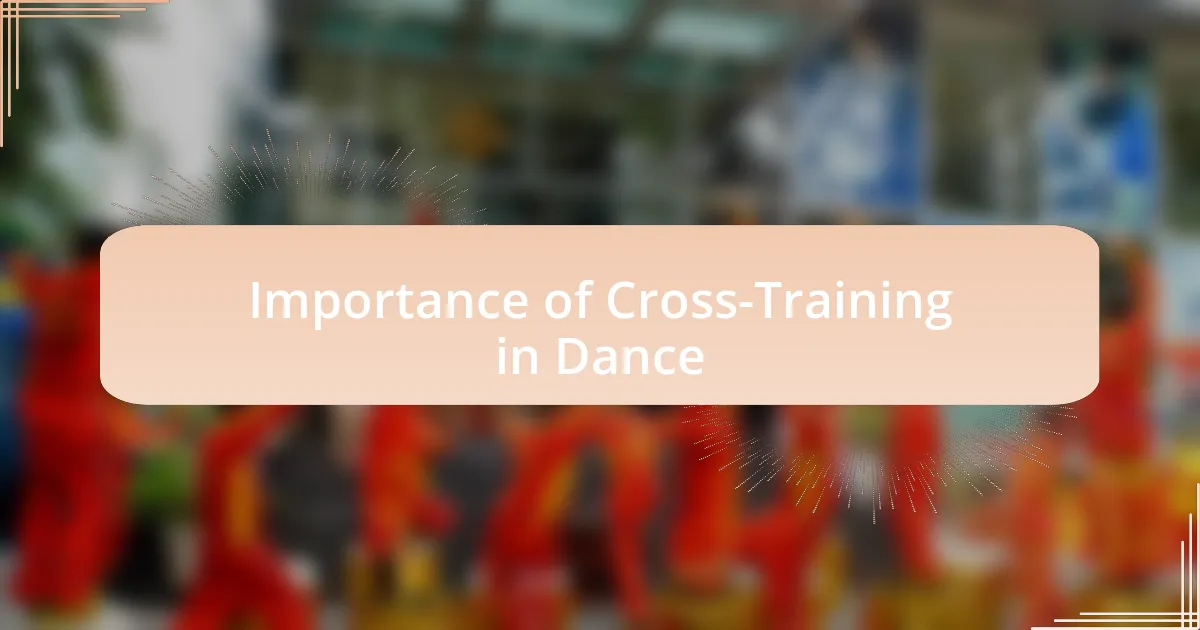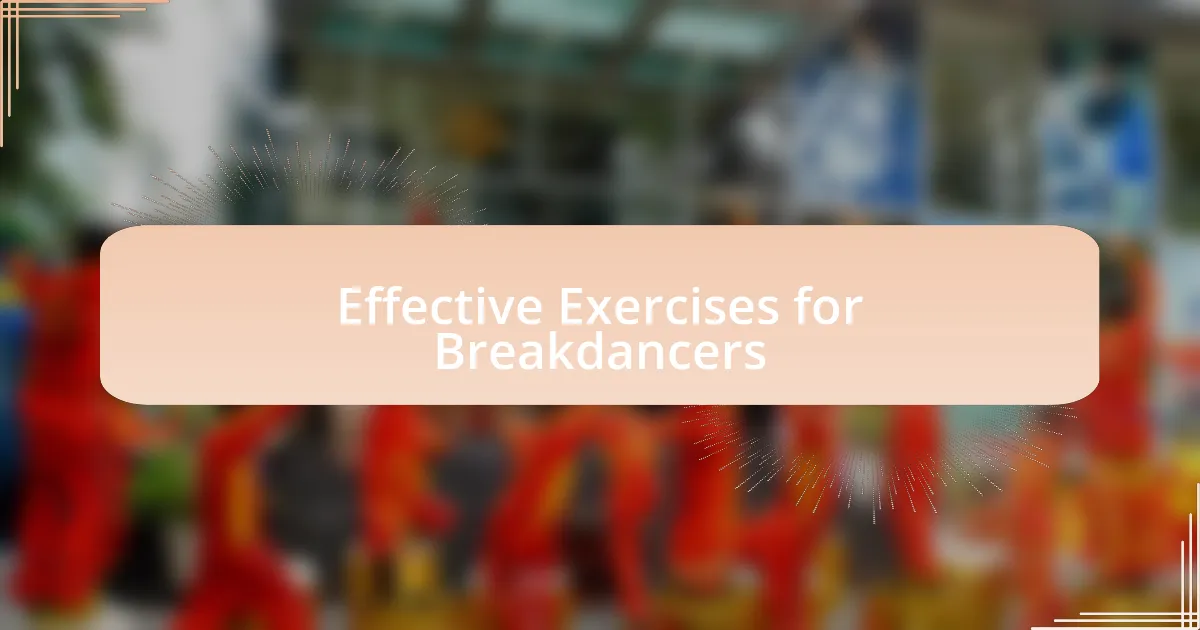Key takeaways:
- Cross-training significantly enhances dancing performance by improving strength, flexibility, and creativity, leading to better control and endurance in breakdancing.
- Incorporating diverse training methods, such as yoga and martial arts, fosters skill development and community connections, enriching the overall dance experience.
- Challenges like time management and physical fatigue can arise during cross-training, emphasizing the need for balance and careful attention to one’s body.
- Nutrition plays a crucial role in supporting energy levels and performance, highlighting the connection between diet and dance abilities.

Understanding Cross-Training Benefits
Cross-training has truly been a game-changer for my dancing journey. When I started incorporating strength training and flexibility exercises, I noticed a remarkable improvement in my endurance and overall technique. Have you ever felt that moment when you land a move just right? It’s like everything clicks, and cross-training can definitely help you achieve that.
I vividly remember a time when I struggled with a particularly challenging spin. Frustration set in, and I felt like giving up. But after focusing on core exercises outside of my usual dance practice, I found my spins became more controlled and fluid. Isn’t it incredible how something seemingly unrelated can enhance your primary discipline? I’ve learned that building strength helps prevent injuries too, which is crucial in breaking.
Moreover, diversity in training can spark creativity. Engaging in different styles, like yoga or martial arts, has not only improved my balance but also inspired new moves in my breakdancing routine. Have you ever tried something outside your comfort zone? That fresh perspective can elevate your dance practice in ways you never imagined.

Importance of Cross-Training in Dance
Cross-training plays a crucial role in enhancing a dancer’s performance, particularly in breakdancing, where strength and mobility are essential. I once participated in a weightlifting class, thinking it would just be a casual workout. To my surprise, those sessions transformed my power moves; I could pull off flips and freezes with newfound strength. Have you ever experienced that surge of confidence that comes when you push your limits?
One of the most exciting aspects of cross-training is the cross-pollination of skills. For instance, while training in Pilates, I realized how much my core stability improved my control during complex footwork. It’s almost like sharpening a tool; you don’t just make one tool better, you enhance the whole toolkit. Have you noticed how even small changes in your training can lead to unexpected breakthroughs in your dance?
Additionally, cross-training introduces a sense of community and shared learning. I remember attending a dance workshop that incorporated elements of capoeira, and the energy was electric! Not only did I learn new techniques, but I also connected with dancers from different backgrounds. This fusion can lead to exciting collaborations and friendships. Isn’t it amazing how expanding your horizons can enhance your dance journey?

Overview of Breakdancing Techniques
One of the most defining features of breakdancing is its array of foundational techniques, each requiring a unique blend of strength, balance, and creativity. I remember when I first tackled the windmill; those initial attempts felt like I was trying to defy gravity. But with practice, I started to see how the angles of my body and the momentum worked together like a dance partner, guiding me into smoother movements. Have you ever felt that exhilarating moment when a challenging move finally clicks?
Another essential technique is the freeze. When I first learned the baby freeze, I felt this rush of power as I balanced on my arm. It’s a statement of control and artistry, showcasing not just physical strength but also the spirit of breakdancing. The pressure of executing it in front of peers can be daunting, but there’s this reward in nailing it, almost like claiming a small victory. Have you ever experienced that thrill of mastering a new freeze that adds to your personal style?
Footwork is where imagination meets technique. Exploring different steps and transitions felt like discovering a new language in breakdancing. I often found myself experimenting during cyphers, allowing the rhythm to dictate my movements. It was thrilling to see how a simple step could evolve into something more intricate just by adding a slight twist or change in timing. Isn’t it fascinating how the same technique can manifest in so many personal ways?

Effective Exercises for Breakdancers
One exercise that significantly improved my breakdancing was incorporating basic calisthenics, like push-ups and squats, into my routine. I remember doing sets of explosive push-ups, which helped build the upper body strength I needed for those tricky freezes. Have you ever noticed how a strong core can transform your control over movements? It’s like finding an untapped reservoir of power that elevates every spin and freeze.
Another effective exercise I found fascinating was practicing dynamic stretches, particularly leg swings and hip openers. They not only improved my flexibility but also helped with the fluidity of my footwork. I still recall the first time I nailed a swift transition from a spin into a quick freeze; the ease of movement was exhilarating, almost like gliding through air. Have you tried integrating flexibility drills into your warm-up? You might be surprised by how they enhance your performance.
Lastly, I can’t emphasize enough the benefits of plyometric workouts, such as box jumps or jump squats. These build explosive strength and agility, crucial for executing high-energy moves during a battle. I remember doing box jumps on a rainy day, feeling the surge of adrenaline as I leaped higher each time. The sense of propulsion not only boosts my confidence but brings a freshness to my routines. What if this power could refine your signature moves and take your flow to new heights?

My Personal Cross-Training Journey
My journey in cross-training for dance has been nothing short of transformative. I vividly recall a moment at the gym, where I opted for a session of yoga instead of hitting the weights. As I flowed through the poses, the balance and breath control I developed not only heightened my awareness but also revolutionized my approach to breaking. Have you ever felt a new form of strength emerging from stillness?
One of the most eye-opening experiences was when I began incorporating martial arts drills into my cross-training routine. The agility from practicing kick techniques and footwork mirrored the quick transitions needed in breaking. I remember sparring with a friend and feeling the rhythm of my movements shift, as if I was dancing in sync with my opponent. Doesn’t it make you wonder how something seemingly unrelated could enhance your flow on the dance floor?
Nutrition also played a key role in my cross-training journey. I started focusing on meal prep, ensuring I fueled my body with nutritious choices. One day, after a rigorous training session, I treated myself to a smoothie packed with greens and protein. The energy boost felt like a direct lift, allowing me to tackle new moves with enthusiasm. Have you considered how what you eat influences your performance? It’s fascinating to see the connections between how I treat my body and how I dance.

Challenges Faced During Cross-Training
The journey of cross-training isn’t without its hurdles. While I found joy in picking up new skills, adapting to different movement styles often left me frustrated. I remember juggling various techniques and, at times, feeling a disconnect between what my body was accustomed to and what these new practices required. Have you ever tried to integrate a completely different style and felt like a beginner again?
Then there’s the issue of time management. Balancing cross-training with my dance schedule was challenging. I vividly recall one week where I had to decide between an extra dance practice or attending a crucial martial arts session. The anxiety of potentially missing out on developing my breaking skills weighed heavily on me. How do you prioritize when every element feels so essential to your growth?
Lastly, the physical demands of cross-training sometimes led to fatigue and even minor injuries. I can’t forget the day I pushed myself too hard in a strength class, leaving me sore for days and hindered in my dance practice. It’s a delicate balance to strike; pushing your limits is crucial, but understanding when to listen to your body can make all the difference. Have you ever experienced that moment where you just knew you needed to rest?